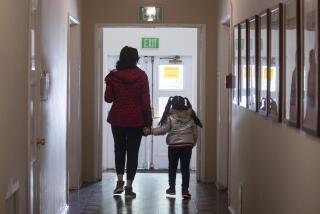Courts Could Offer Coordinated Help
California law restricts domestic violence courts to an education and punishment design, which research demonstrates has no enduring positive effect after five years. Better results can be produced by using a “one-family, one-judge” model that incorporates authentic treatment for all of those impacted. A good opportunity to take a step toward such a model would be at Saturday’s meeting in Los Angeles of the state Assembly’s newly appointed Select Committee on Domestic Violence.
Dysfunctional families are characterized by low self-esteem, poor coping skills and inappropriate conflict resolution. Unfortunately, that pathology is often replicated generation after generation. By focusing on children’s needs, the services and program requirements imposed on the adults will be readily identified.
According to the California Judicial Council’s 2000 Report, substance abuse exists in at least 70% of court cases that resulted in 100,000 California children being placed in foster care. Many adults brought before domestic violence courts are indigent or the working poor for whom treatment is a false hope unless the state funds it.
The domestic violence law and the courts must be revamped to successfully respond to a broad range of social problems. Currently, our courts are not organized to allow sufficient opportunity to coordinate all responses to the fundamental causes underlying a case. Collectively, courts possess the plenary powers to meet such goals, but they break up their authority so that each department acts as though it possesses only circumscribed discrete powers. For example, courts limit themselves to only delinquency or mental heath or child support.
Since more than 90% of all cases filed are completed without trial, the justice system and its component agencies ought to ensure that comprehensive wraparound human services are integrated in an optimal way. Failure to do so perpetuates the current situation in which the courts continually are confronted by repeat offenders, resulting in dismal outcomes and overconsumption of resources.
The justice system should provide a more coordinated, seamless spectrum of services so that not only cases but human problems and dilemmas are resolved.
When an agreed-upon threshold of dysfunction is detected by law enforcement or other human service agencies, such as schools, health care providers or public social services, a case could be filed in a plenary court on behalf of any individual needing help.
The judicial officer in a plenary court would possess the broad legal authority and immediate access to all needed justice and human services agencies. Those agencies’ representatives could obtain a professional assessment of the psychosocial needs of those before the court, secure a comprehensive treatment plan and have a team to implement the court orders.
An encounter initiated with a single individual could lead to essential unmet psychosocial requirements of all family members also being satisfied. Then all of those impacted would receive appropriate services and follow-up to support positive outcomes. Coping skills, self-esteem, conflict resolution, psychological and physical health (including sobriety), education and vocational talents and job placement would all be promoted.
This “one-family, one-judge” proposal would not replace but only enhance the existing system. We should redefine the outputs, workload and measurements of success of the justice system and its component agencies to also include the achievement of long-term positive life outcomes by those who go through the system.
More to Read
Sign up for Essential California
The most important California stories and recommendations in your inbox every morning.
You may occasionally receive promotional content from the Los Angeles Times.










